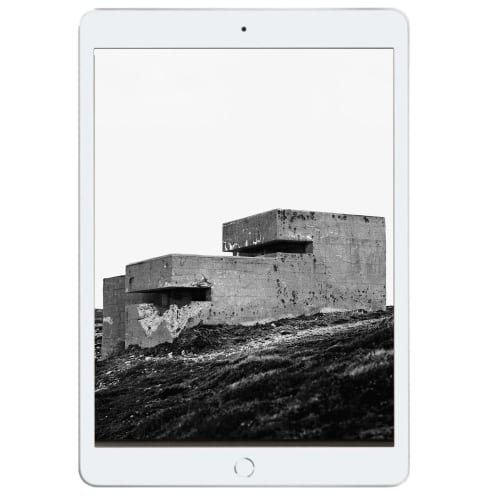DON CAMERON IS A 21ST century Renaissance man: filmmaker; director of music videos; importer of rare mid to late 20th century European furniture; interior designer; photographer and now designer of some of the most compelling furniture to be launched on these shores for some time. The “Untitled” sofas, coffee tables, desk lamps, floor lamps, desks and stools are directly inspired by brutalist architecture depicted in the photographs he spent from 2000-2020 “collecting” (and which formed his breakout 2020 exhibition in Sydney).
A hefty, solid walnut desk is informed by a blunt, bull-nosed bunker on Alderney, the northernmost of the inhabitable Channel Islands, its rounded forms echoing an architecture that was designed to throw little shadow, blending instead into bleak surrounds. “I was intrigued by the idea of scaling down this robust monumentality to domestic dimension,” says Cameron. “It’s almost as if you can sit on a bunker.”
A blocky steel sofa mimics the elemental structure of another bunker on the isle of Guernsey. The stitch-welding joinery technique is left evident rather than polished or brushed to a seamless finish – much as the rudimentary concrete construction of the bunker remains clear to this day. “I was concerned that if I did a perfect finish all over, it would look like a refrigerator or a dishwasher,” he notes, with trademark laconic humour. “Instead, I wanted to celebrate the painstaking process which includes hand-guillotining the sheets of steel and stitching the pieces together incrementally to avoid the metal distorting.” A couple of steel floor lamps are inspired by the 1976 Church of the Most Holy Trinity on the outskirts of Vienna. Also known as the Wotruba Church, after its Czech- Hungarian architect Fritz Wotruba, its apparently haphazard massing of 152 concrete blocks forms an oblique homage to the 13th-century Gothic cathedral of Chartres. The way light falls across the stacked blocky volumes of Cameron’s lumieres suggests the shadow play of the canted fenestration, as seen from within the Wotruba cathedral – which is where the Chartres connection becomes most evident.
Timber coffee tables featuring skateboard ramp style sculptural swooshes are influenced by the roofline of a private house in Bordeaux, designed and delivered in the mid-1960s by French architect Claude Parent.
Despite the distinct formal lineage of each piece, Cameron insists the material research is just as important to this collection. “Essentially, every object is made from just one material. The desk and stool are made of solid 70 millimetre slabs of walnut, a colossal amount of timber. The lights are constructed uniquely of steel. You can see the process inscribed on the surface of the objects, which for me was the only way I could convey that same rugged patina that I saw on those extraordinary buildings.”
Cameron first encountered brutalist architecture in Switzerland when, fresh out of film school and with some era-defining music videos under his belt, he’d begun filming commercials for European brands including Audi, Braun and L’Oreal. On a job for Swiss Tourism, he stumbled across concrete churches from the middle of the century that seemed to have surged from villages with roots in the Middle Ages. And so began a two-decade obsession photographing – not so much to document as to collect (Cameron is an inveterate collector) – what some think of as brutalist beauties; others as concrete cancer incarnate.
“Going off on my own to photograph silent things in isolation was about having something that would nourish my desire to create, that came from outside the world of commercial imperatives,” he said in 2020 about his exhibition of large-scale black- and-white images titled Communion.
Cameron’s inaugural furniture collection is not, he is adamant, about mimicking historically significant architectural forms. Rather, it’s about tapping into a frisson of history “to create objects that feel like they have perhaps always existed”. Timelessness guaranteed, future heirlooms.
Translations, Gallery Sally Dan-Cuthbert, Sydney, from September 2 to October 2.

